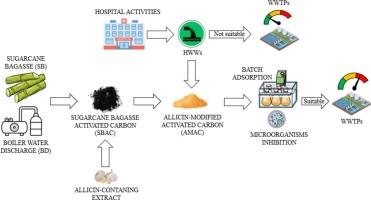环保型活性炭去除医院废水中的耐药菌
Q1 Environmental Science
Environmental Nanotechnology, Monitoring and Management
Pub Date : 2025-07-16
DOI:10.1016/j.enmm.2025.101088
引用次数: 0
摘要
耐抗生素细菌的增加推动了对天然抗菌替代品的研究。大蒜素是一种在新鲜碾碎的蒜瓣中形成的化合物,具有抗菌性能,但在水环境中稳定性差。因此,本研究旨在探索大蒜素修饰活性炭(AMAC)的合成和表征,并评估其在去除医院合成废水(HWW)中大肠杆菌的潜在应用。通过水热法(在200℃下加热24 h,然后在450℃下活化10 min)将巴西当地一家酒精厂提供的甘蔗渣(SB)转化为活性炭(SBAC)。从新鲜大蒜中提取大蒜素,并将其浸渍在SBAC表面,得到平均直径为105µm的AMAC。对材料进行了表征(FT-IR, Raman和n2 -物理吸附),揭示了明显的结构和表面修饰。通过最小抑菌浓度(MIC)试验、最小杀菌浓度(MBC)试验和圆盘扩散试验,对大蒜素对大肠杆菌的抑菌活性进行了评价,结果表明,大蒜素对大肠杆菌的生长具有抑制作用。吸附实验表明,与AMAC在去离子水和无菌水中相比,AMAC在合成水中对大肠杆菌的去除效率提高了3%。这种改善归因于AMAC与废水成分之间的积极相互作用和协同效应。换句话说,这意味着即使存在有机和无机分子,AMAC也可以用于去除大肠杆菌,而不会损失任何效率。该研究还强调了AMAC的环境友好型合成工艺及其作为不使用抗生素治疗hww的可持续解决方案的潜力,从而避免了药物化合物可能释放到环境中。结果表明,AMAC可能是一种可行的替代方法,可以加强对受污染水源中抗生素耐药细菌的去除,有助于公共卫生和环境保护。本文章由计算机程序翻译,如有差异,请以英文原文为准。

Environmentally-friendly activated carbon for the removal of antibiotic-resistant bacteria removal from hospital wastewater
The rise of antibiotic-resistant bacteria has driven research into natural antimicrobial alternatives. Allicin, a compound formed in freshly crushed garlic cloves, exhibits antibacterial properties but suffers from poor stability in aqueous environments. That is why this study aimed to explore the synthesis and characterization of allicin-modified activated carbon (AMAC) and evaluate its potential application removing Escherichia coli from synthetic hospital wastewater (HWW). Sugarcane bagasse (SB) provided by a local Brazilian alcohol mill was transformed into activated carbon (SBAC) through a hydrothermal process (heating at 200 °C for 24 h followed by activation at 450 °C for 10 min). Allicin extract was obtained from fresh garlic and impregnated onto the SBAC surface, resulting in AMAC with 105 µm mean diameter. The materials were characterized (FT-IR, Raman and N2-physisorption), revealing significant structural and surface modifications. The antibacterial activity of allicin against E. coli was assessed through minimum inhibitory concentration (MIC), minimum bactericidal concentration (MBC) trials and disk diffusion, demonstrating effective bacterial growth inhibition, as expected. Adsorption assays showed that AMAC enhanced E. coli removal efficiency in synthetic HWW by 3 %, compared to the AMAC in deionized and sterile water. This improvement was attributed to the positive interactions and synergistic effects between AMAC and the wastewater constituents. In other words, it means that AMAC can be used in the E. coli removal even in presence of organic and inorganic molecules without any loss of efficiency. The study also highlights the environmentally friendly synthesis process of AMAC and its potential as a sustainable solution for treating HWWs without the use of antibiotics, thus avoiding the potential release of pharmaceutical compounds into the environment. The results suggest that AMAC could be a viable alternative for enhancing the removal of antibiotic-resistant bacteria from contaminated water sources, contributing to public health and environmental protection.
求助全文
通过发布文献求助,成功后即可免费获取论文全文。
去求助
来源期刊

Environmental Nanotechnology, Monitoring and Management
Environmental Science-Water Science and Technology
CiteScore
13.00
自引率
0.00%
发文量
132
审稿时长
48 days
期刊介绍:
Environmental Nanotechnology, Monitoring and Management is a journal devoted to the publication of peer reviewed original research on environmental nanotechnologies, monitoring studies and management for water, soil , waste and human health samples. Critical review articles, short communications and scientific policy briefs are also welcome. The journal will include all environmental matrices except air. Nanomaterials were suggested as efficient cost-effective and environmental friendly alternative to existing treatment materials, from the standpoints of both resource conservation and environmental remediation. The journal aims to receive papers in the field of nanotechnology covering; Developments of new nanosorbents for: •Groundwater, drinking water and wastewater treatment •Remediation of contaminated sites •Assessment of novel nanotechnologies including sustainability and life cycle implications Monitoring and Management papers should cover the fields of: •Novel analytical methods applied to environmental and health samples •Fate and transport of pollutants in the environment •Case studies covering environmental monitoring and public health •Water and soil prevention and legislation •Industrial and hazardous waste- legislation, characterisation, management practices, minimization, treatment and disposal •Environmental management and remediation
 求助内容:
求助内容: 应助结果提醒方式:
应助结果提醒方式:


